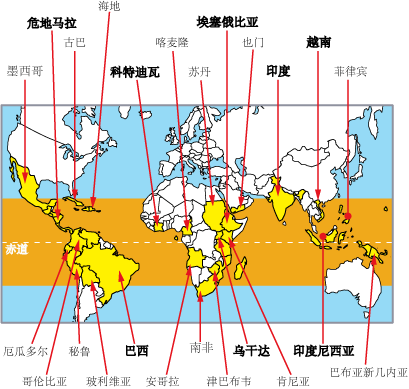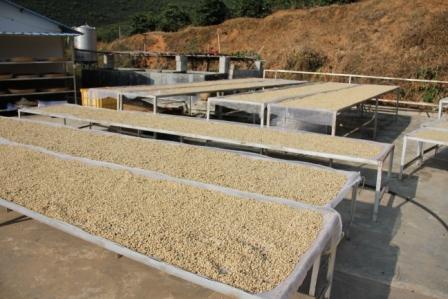The unique quality of Italian concentrated blending and the flavor of Italian concentrated blending.
Commercial coffee trees planted are mainly divided into three categories: Arabica (Arabica), Robusta (Robusta) and Liberika (Liberica). Among them, Liberika (Liberica) is rarely seen because of its small output.

It is generally believed that Arabica coffee beans grown at high altitudes have elegant aroma and taste, while Robusta coffee beans grown at low altitudes have the bitterness of wood and Punch.
In Italian coffee shops, it is most common to mix 10% 40% Robusta beans with Arabica coffee beans as the base.
The higher the proportion of Robusta coffee beans mixed, the stronger the espresso flavor and the easier it is to form crema. However, it also loses its original delicacy and aroma.
In many cafes (Australia, Seattle, USA, etc.), most of them use 100% Arabica coffee beans
The flavor of espresso does not only depend on the roasting effect of coffee beans, but also comes from the blending of coffee beans.
The ideal Italian concentrated (espresso) flavor should be that all the elements can be balanced and the taste is bright. After drinking it, the throat feels mellow rather than bitter.
To put it more specifically, it should have moderate acidity, bitterness, sweetness, rich taste (flavor), solid and strong consistency (body), and a lasting finish (aftertaste) that feels like a refreshing sour citrus.
And when making cappuccino (Cappuccino), it can blend with milk, and the sweetness of milk is clear and prominent. In this way, even without sugar, it will be delicious.
Use 100% Arabica (Arabica) coffee beans, divided into single Italian concentrated beans, or mixed Italian concentrated beans.
What the latter needs is to choose to match each other to enhance the flavor, increase the overall taste and rhyme, and supplement the lack of consistency of a single variety.
Let me give you an example:
Japan's espresso has mixed four kinds of coffee beans, based on Brazilian beans, and then used Kenyan, Bolivian and Papuan beans to make up for the missing elements. All four of the above are Arabica.
The principle explains: "Brazilian beans used as a base use beans with a cocoa-like flavor of chocolate (flavor), while Kenyan beans are made of beans with a refreshing sour taste of lemon or grapefruit, the sour taste of citrus that exudes a refreshing aftertaste. Bolivian beans taste similar to Brazilian beans. Adding the mixture is to enhance the taste of Brazilian beans. Papuan beans are high in oil (crema) and can be used to increase body. "
Important Notice :
前街咖啡 FrontStreet Coffee has moved to new addredd:
FrontStreet Coffee Address: 315,Donghua East Road,GuangZhou
Tel:020 38364473
- Prev

Coffee producing area there are 53 coffee producing areas in the world. Suriname coffee.
Surinam Suriname Suriname (Surinam) is the first country in South America to grow coffee, and Norway was once a major importer of its coffee products. However, the country's output is very small today, and it is mentioned here only for historical reasons. The Dutch, who settled in Suriname in 1667, introduced coffee trees from Java in the early 18th century. The first coffee trees were made by Asmst.
- Next

Characteristics of Arabica beans Coffee producing countries Coffee producing countries Venezuela
Venezuela's distinctive manor coffee comes from this oil-rich country. Oil was once considered to be the main export of Venezuela. Although coffee trees were introduced from Martinique in 1730 and Venezuela, coffee production was almost abandoned at the height of the oil industry. Recently, the coffee plantation has begun to recover, and the original Tippica (
Related
- Guji coffee producing area of Guji, Ethiopia: Humbela, Shakiso, Wulaga
- What is the most expensive variety of Qiloso in BOP multi-variety group?
- How to store the coffee beans bought home?
- Why are Yemeni coffee beans so rare now?
- Ethiopian Sidamo all Red Fruit Sun Sun Santa Vini Coffee beans
- SOE is mostly sour? What does it mean? Is it a single bean? what's the difference between it and Italian blending?
- Is Italian coffee beans suitable for making hand-brewed coffee?
- How to choose coffee beans when making cold coffee? What kind of coffee beans are suitable for making cold coffee?
- Just entered the pit to make coffee, what kind of coffee beans should be chosen?
- Can only Japan buy real Blue Mountain Coffee? What are authentic Jamaican Blue Mountain coffee beans?

